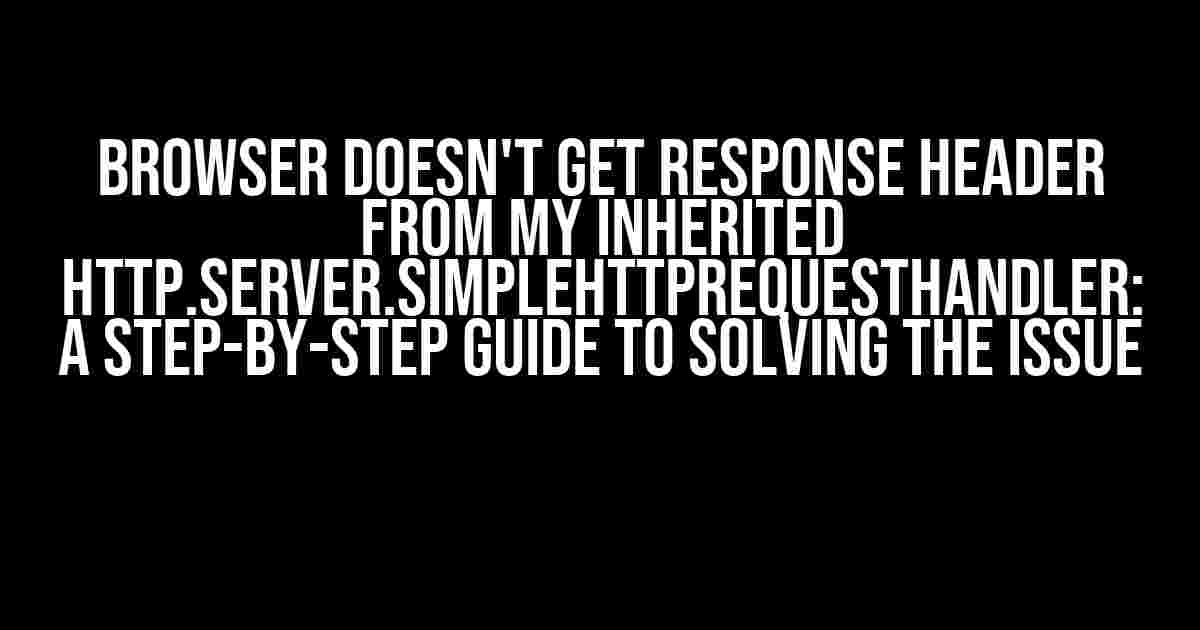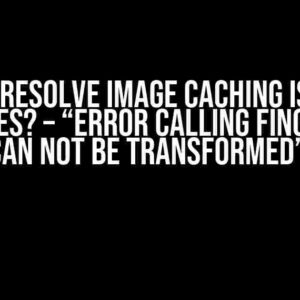Are you tired of struggling with the frustrating issue of your browser not receiving response headers from your inherited http.server.SimpleHTTPRequestHandler? Well, worry no more! In this comprehensive guide, we’ll take you by the hand and walk you through the process of resolving this pesky problem once and for all.
Understanding the Issue
The http.server.SimpleHTTPRequestHandler is a built-in Python class that allows you to create a simple HTTP server. However, when you inherit from this class, you may encounter an issue where the browser doesn’t receive the response headers from your custom handler. This can be frustrating, especially when you need to set specific headers for your application.
Why Does This Happen?
The reason for this issue lies in the way the SimpleHTTPRequestHandler class handles response headers. By default, it doesn’t send any headers to the browser. When you inherit from this class, you need to explicitly set the response headers to ensure they’re sent to the browser.
Solving the Issue
Now that we understand the root cause of the problem, let’s dive into the solution. Follow these step-by-step instructions to resolve the issue:
Step 1: Create a Custom Handler Class
import http.server
import socketserver
class CustomHandler(http.server.SimpleHTTPRequestHandler):
def do_GET(self):
self.send_response(200)
self.send_header("Content-type", "text/html")
self.end_headers()
self.wfile.write(b"<html><body><p>Hello, World!</p></body></html>")
In this example, we’ve created a custom handler class called CustomHandler that inherits from http.server.SimpleHTTPRequestHandler. We’ve overridden the do_GET method to set the response code, content type, and send the response body.
Step 2: Set the Response Headers
In the do_GET method, we need to set the response headers using the send_header method. In this example, we’ve set the Content-type header to text/html. You can set any header you need by calling the send_header method and passing the header name and value as arguments.
Step 3: Send the Response Headers
After setting the response headers, we need to call the end_headers method to send the headers to the browser. This method marks the end of the headers and indicates that the response body is about to be sent.
Step 4: Send the Response Body
Finally, we send the response body using the wfile.write method. In this example, we’ve sent a simple HTML page with the text “Hello, World!”. You can send any response body you need by calling the wfile.write method and passing the response data as an argument.
Example Code
import http.server
import socketserver
class CustomHandler(http.server.SimpleHTTPRequestHandler):
def do_GET(self):
self.send_response(200)
self.send_header("Content-type", "text/html")
self.send_header("Custom-Header", "Custom-Value")
self.end_headers()
self.wfile.write(b"<html><body><p>Hello, World!</p></body></html>")
PORT = 8000
httpd = socketserver.TCPServer(("", PORT), CustomHandler)
print(f"Serving at port {PORT}")
httpd.serve_forever()
In this example, we’ve created a custom handler class that sets the Content-type header to text/html and a custom header called Custom-Header with the value Custom-Value. We’ve then created a TCP server and started it on port 8000.
Testing the Solution
Open a browser and navigate to http://localhost:8000. You should see a simple HTML page with the text “Hello, World!”. Press F12 to open the developer tools and inspect the response headers. You should see the Content-type and Custom-Header headers in the response.
Common Gotchas
Forgetting to Call end_headers()
One common mistake is forgetting to call the end_headers method after setting the response headers. This can cause the browser to receive an incomplete response, leading to unexpected behavior.
Not Sending the Response Body
Another common mistake is not sending the response body after setting the response headers. This can cause the browser to receive an empty response, leading to a blank page or error.
Not Handling Errors
It’s essential to handle errors and exceptions properly in your custom handler class. Failing to do so can cause the server to crash or return unexpected responses to the browser.
Conclusion
In this comprehensive guide, we’ve covered the issue of the browser not receiving response headers from an inherited http.server.SimpleHTTPRequestHandler. We’ve walked you through the process of creating a custom handler class, setting response headers, and sending the response body. By following these steps and avoiding common gotchas, you should be able to resolve the issue and create a robust HTTP server using Python.
Frequently Asked Questions
Q: What is the http.server.SimpleHTTPRequestHandler class?
A: The http.server.SimpleHTTPRequestHandler class is a built-in Python class that allows you to create a simple HTTP server. It provides a basic implementation of an HTTP request handler.
Q: Why do I need to set response headers?
A: Response headers are essential for communicating information about the response to the browser. They can specify the content type, caching instructions, and other metadata that helps the browser display the response correctly.
Q: How do I set multiple response headers?
A: You can set multiple response headers by calling the send_header method multiple times, passing the header name and value as arguments.
Q: What happens if I don’t call end_headers()?
A: If you don’t call end_headers(), the browser may not receive the response headers, leading to unexpected behavior or errors.
| Header Name | Header Value |
|---|---|
| Content-type | text/html |
| Custom-Header | Custom-Value |
In this table, we’ve listed the response headers set in our custom handler class. You can add or modify headers as needed to suit your application requirements.
We hope this comprehensive guide has helped you resolve the issue of the browser not receiving response headers from your inherited http.server.SimpleHTTPRequestHandler. If you have any further questions or need more assistance, please don’t hesitate to ask.
- Python 3.x documentation: http.server
- Stack Overflow: Custom HTTP headers in Python SimpleHTTPServer
- W3C: HTTP/1.1: Header Field Definitions
Happy coding!
Here are 5 Q&A about “Browser doesn’t get response header from my inherited http.server.SimpleHTTPRequestHandler” :
Frequently Asked Question
Having trouble with your HTTP request handler? We’ve got you covered! Check out these frequently asked questions to troubleshoot your issue.
Why doesn’t my browser receive the response headers from my custom HTTP request handler?
This is because the `SimpleHTTPRequestHandler` class in Python’s `http.server` module only sets a limited set of headers by default. If you want to send custom headers, you need to override the `end_headers` method in your custom handler.
How do I set custom response headers in my inherited `SimpleHTTPRequestHandler`?
You can set custom headers by calling `self.send_header(header_name, header_value)` in your `do_GET` (or other request method) method. Make sure to call `self.end_headers()` after setting all your headers.
What if I want to set headers for all requests, not just GET requests?
You can override the `send_response` method to set headers for all requests. This method is called before the specific request method (e.g., `do_GET`) and allows you to set headers for all responses.
Why don’t I see my custom headers in the browser’s dev tools?
Make sure you’re checking the right place in the dev tools! Custom headers might not show up in the “Response Headers” section, but you can find them in the “Network” tab, under the “Headers” subsection.
Can I set headers dynamically based on the request or response content?
Absolutely! You can access the request and response objects in your custom handler and set headers based on their attributes or content. Just be mindful of the header naming conventions and formatting rules.







